Vol 4 No. 19 TROPIC LIGHTNING NEWS May 12, 1969
Index
 |
THE 65th ENGINEERS’ A Company is a versatile partner for 1st Brigade units operating out of Tay Ninh. The engineers are accomplished at destruction as the South Vietnamese Regional Force soldier watching the elimination of an NVA bunker at right can attest. The men of the Whiskey Fifth are also art1sts of construction, however, using their talents for such operations as spanning the Soui Ben Rong River (photo at left). For photo features showing the engineers at work see the center spread on pages 4 and 5, page 7. |  |
Tropic Lightning Raids Foe’s Pantries
Rice-naping Wolfhounds Dig 21 Tons Near Dau
Tieng
DAU TIENG - Two companies of the 1st Battalion, 27th Infantry Wolfhounds knew
it was going to be a "rice" day recently when they uncovered 42,000 pounds of
the grain in several caches near the 3d Brigade base camp here.
Alpha and Bravo Companies were conducting sweep operations in the Boi Loi
Woods, 12 miles southeast of Dau Tieng, when the discoveries were made.
Sergeant First Class Rodney E. Crosby, Santa Monica, Calif., who was in
charge of Bravo Company lead platoon, spotted a few bags of rice in a hedge-row. With the
help of Sergeant Lanny R. Vachs, Jonestown, Tenn., he checked the area and discovered a
ditch about five feet deep, three feet wide and 35 to 40 meters long.
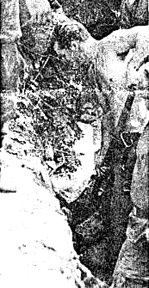 The rice stored in canvas bags with plastic bags as protective covering, was heaped in the
ditch.
The rice stored in canvas bags with plastic bags as protective covering, was heaped in the
ditch.
In addition to the rice, Bravo Company troopers also uncovered an old AK-47
assault rifle, three AK-47 magazines and 1,100 pounds of salt.
Alpha Company, working in close coordination with Bravo Company, discovered
an estimated 14,050 pounds of rice in their area of operation. About 10,000 additional
pounds of rice had been destroyed by weather. The company also located 200 pounds of salt
and assorted pots and pans which showed signs of having been used in the last 12 hours.
On the same operation, Alpha Company located and destroyed nine Viet Cong
claymore mines, three small bottles of morphine and a bicycle tire pump. One 60mm mortar
base plate was evacuated to Fire Support Mahone.
"This is the largest rice cache we have uncovered since I have commanded
the battalion," said Lieutenant Colonel James T. Bradley of Arlington, Va.,
Wolfhounds commander. "This rice cache discovery, plus arms cache discoveries by
other 3rd Brigade troops in the last several days is going to seriously hamper the
enemy’s effectiveness in the field."
CONVERTED RICE - (right) A Wolfhound of B Company,
1st Battalion, 27th Infantry digs up part of a 42,000-pound rice cache found near Dau
Tieng. (PHOTO BY CPT. R.A. STEINHAUSEN JR.)
Let Them Eat Cake, Say
Warriors After Rice Find
CU CHI - Nearly ten thousand pounds of rice intended for
Viet Cong and North Vietnamese Army forces will never reach them, thanks to two 2d Brigade
soldiers with sharp eyes.
Private First Class Valentine Montesdeoca, Los Angeles, Calif., and Private
First Class Dwain Taylor, Port Huron, Mich, uncovered the cache during a sweeping
operation for the 2d Battalion, 12th Infantry Warriors near Fire Support Base Pershing.
The bags of food were stacked near a path and covered with rice straw and
branches. "I just happened to see them," Taylor said. "They weren't
camouflaged very well."
When the cache was uncovered, Fire Brigade troopers found 98 sacks, each
holding 100 pounds of unpolished rice. There were fresh oxcart tracks in the area, which
indicated that the pile had been there less than 48 hours.
The tracks led from a make-shift dock on a nearby canal. A sunken sampan,
left from other recent activity in the area, still rested in the water.
A Chinook brought the cache to Cu Chi, where the rice was turned over to
Helping Hand and Civic Action groups for distribution to Vietnamese civilians.
| It couldn’t make any difference to anyone you shoot, but you must keep your ammunition and magazines clean. Weapons often will simply not digest dirty ammo. In an environment where dust, mud and dirt are the rule, you must be extra careful lest you be left with no means of defense. Cleanliness is next to security. |
Prowling Bobcats Tear Up NVA
Unit in Ho Bo Woods
By SGT Jan F. Anderson
CU CHI - Two prowling Companies of 1st Battalion (Mechanized), 5th Infantry
Bobcats flushed out an unknown size NVA unit and killed 50 enemy in a recent two-day
operation near the Ho Bo Woods. After laagering for the night in the woods, the Bobcats' A
Company moved out to sweep an area of rice paddies and potentially dangerous hedge rows.
As the company was returning to the laager after a day which up to then had been
uneventful, a nearby hedge row suddenly erupted in a hail of rocket-propelled grenades and
AK-47 rifle fire.
The Lead armored personnel carrier caught in the center of the action used
its .50 caliber machine guns to slam a torrent of suppressive fire at the NVA. Having
taken the initiative, the Tropic Lightning troops called in air strikes to smash the
fortified bunkers and tunnels the enemy had constructed.
Then it became routine as (Continued on Back Page)
 |
| TOTE THAT BAG, LIFT THAT RICE - Warriors of the 2d Battalion, 12th Infantry stack bags of 10,000 pounds of rice they found in an enemy cache. Chinook helicopters evacuated the grain to Cu Chi, where it was prepared for distribution to Vietnamese civilians. |
Page 2 TROPIC LIGHTNING NEWS May 12, 1969
Decorated
| BRONZE STAR MEDAL (HEROISM) | |
| LTC William E. Klein, HHC, 1st
Bn, 5th Inf LTC Eelward C Gibson, HHC, 65th Engr. Bn. LTC Forest E. Pierce, HHB, 7th Bn, 11th Arty MAJ Samuel Malave-Garcia DISCOM CPT Alton M Fennell, HHC, 2d Bn, 22d Inf CPT Paul D Conley, HHC, 2d Bn, 22d Inf CPT Charles P Ervin, Co C, 1st Bn, 27th Inf CPT Randall Yeargan, Co A, 1st Bn, 5th Inf CPT Elcie Adams, A Co, 4th Bn, 9th Inf CPT Ardre F. Blackmon, A Co, 3d Bn, 22d Inf CPT Gregory J. Hayward, B Co, 1st Bn, 5th Inf CPT Carl Sweatman, HHC, 3d Bn, 22d Inf CPT Kenneth E. Willingham, Co B 1st Bn, 5th Inf 1LT Lon Rowlett Jr., 1st Bn, 8th Fld Arty 1LT Daniel F. Wall, Co B, 2d Bn, 22d Inf 1LT Clyde Oatts, C Btry, 2d Bn, 77th Fld Arty 1LT Gregory B. Jamieson, Co A, 2d Bn, 12th Inf 1LT Richard E. Hetzel, 25th MP Co 1LT Louis M. Gietka, Co C, 2d Bn, 12th Inf 1LT Edward Zglenski, Co C, 1st Bn, 27th Inf 1LT Gregor P. Schlau, B Co, 2d Bn, 12th Inf 1LT Dorothle J. Gillespie, D Co, 2d Bn, 14th Inf 1LT William S. De Boer, B Co, 1st Bn, 5th Inf 1LT Paul Greenwalt, A Co, 1st Bn, 5th Inf 1LT Martin Beach, A Co, 2d Bn, 12th Inf 1LT George Reese, B Co, 25th Avn Bn 1LT Joseph Rio, C Co, 4th Bn, 23d Inf 2LT Paul B. Grigg, HHB, 2d Bn, 77th Fld Arty 2LT Clyde A. Giddings, A Btry, 1st Bn, 8th Fld Arty WO1 Mark D. Mitchell, HHB, 25th Inf Div Arty CSM William Clevenger, HHB, 7th Bn, 11th Arty PSG Lonnie Jackson, A Co, 1st Bn, 5th Inf SFC Marvin Edwards, HHC, 2d Bn, 27th Inf SFC Robert Wood, Co B, 1st Bn, 5th Inf SFC Harold B. White, Co B, 1st Bn, 5th Inf SFC Curtis C. Dees, Co E, 2d Bn, 12th Inf SSG Charles Martin, A Trp, 3d Sqdn, 4th Cav SSG Robert S. Correia, A Trp, 3d Sqdn, 4th Cav SSG Herman C. Humiston, Co B, 2d Bn, 27th Inf SSG Elbert W. Price, HHB, 2d Bn, 77th Arty SSG Jerry E. O'Malley, A Trp, 3d Sqdn, 4th Cav SGT Richardo Ortegon, Co C, 2d Bn, 22d Inf SGT John S. Gentner, Co A, 2d Bn, 34th Armor SGT Thomas J. Robbins Jr., A Co, 1st Bn, 5th Inf SGT Daniel E. Mackey, Co B, 2d Bn, 22d Inf SGT Thomas E. Vallow, Co C, 1st Bn, 5th Inf |
SGT Miguel Villarreal, A Trp, 3d
Sqdn, 4th Cav SGT James Roth, A Trp, 3d Sqdn, 4th Cav SGT Charles C. Patterson, A Trp, 3d Sqdn, 4th Cav SGT Lloyd M. Pusey, Co B, 1st Bn, 5th Inf SGT Thomas E. Klooz, Co D, 2d Bn, 14th Inf SGT Michael J. McMahan, D Trp, 3d Sqdn, 4th Cav SGT Thomas R. Leetz, A Trp, 3d Sqdn, 4th Cav SGT Gary W. Barlow, A Trp; 3d Sqdn, 4th Cav SGT Henry J. Bales, A Trp, 3d Sqdn, 4th Cav SGT James F. Gruseck, Co A, 25th Avn Bn SP4 Michael Thomas, D Trp, 3d Sqdn, 4th Cav SP4 Donald Kennedy, Co A, 1st Bn, 5th Inf SP4 Donald W. Coldwell, Co A, 2d Bn, 34th Armor SP4 George A. Howard, 38th Inf Plat SP4 Clinton G. Cooper, Co B, 2d Bn, 12th Inf SP4 Albert J. Nichol, A Btry, 1st Bn, 8th Arty SP4 Gary Conner, D Co, 2d Bn, 27th Inf SP4 Rocky A. Poulos, Co A, 2d Bn, 34th Armor SP4 Arthur B. Cohen, Co D, 725th Maint Bn SP4 Thomas R. Broughton, Co D, 4th Bn, 9th Inf SP4 Ronald E. Logan, Co D, 2d Bn 12th Inf SP4 David Edland, Co B, 1st Bn, 5th Inf SP4 Orville P. Billbe, Co B, 2d Bn, 22d Inf SP4 Harold R. Crum, Co B, 2d Bn, 14th Inf SP4 Darrell Frickson, Co B, 2d Bn, 27th Inf SP4 Albert Hicks, A Trp, 3d Sqdn, 4th Cav SP4 Vernon W Wendt, Co B, 1st Bn, 5th Inf SP4 John J. Maioni, HHC, 4th Bn, 23d Inf SP4 Winston Cunningham, C Trp, 3d Sqdn, 4th Cav SP4 John F. Sherwood, Co C, 1st Bn, 27th Inf SP4 Ronald A. Williams Co D, 2d Bn, 12th Inf SP4 Renard Godwin. Co C, 1st Bn, 5th Inf SP4 Jerry L. Rudlaff, Co C, 1st Bn, 5th Inf SP4 Ralph T. Lemme, D Co, 2d Bn, 14th Inf SP4 Ronald P. McTaggart, A Trp, 3d Sqdn, 4th Cav SP4 Willie J. Maull, A Co, 2d Bn, 34th Armor SP4 James L. Thompson C Trp, 3d Sqdn, 4th Cav PFC Jergen Schors, Co B, 1st Bn, 5th Inf PFC Mervin Clark, Co D, 2d Bn, 12th Inf PFC Roy C. Ancira, Co D, 2d Bn, 12th Inf PFC Melvin Bimberg, D Co, 3d Bn, 22d Inf PFC Carlton G. Harwell Co B, 1st Bn, 5th Inf PFC Lee E. Burnor, Co A, 1st Bn, 5th Inf PFC Elias B. Papadimitriou, HHB, 2d Bn, 77th Arty PVT James E. Scanel, Co A, 1st Bn, 5th Inf PVT Bruce M. Kraft, HHB, 2d Bn, 77th Arty |
Rules Changed On Mailing Firearms
Changes in the restrictions applying to the mailing of firearms have recently
been announced by the Department of Defense. The changes apply to military-postal channels
in recognition of provisions of the Gun Control Act of 1968, Public Law 90618.
Firearms may be mailed to and from military post offices under the following
circumstances:
When shipments are official mailings of weapons imported for, sold to, mailed by or issued
to the exclusive use of the United States or any department or agency of the government.
When the weapons are sporting or antique firearms authorized to enter the US
civil postal system.
In all cases the mailed fire-arms for personnel use must be accompanied by an
approved Internal Revenue Service Form 6 (Application and Permit for Importation and
Implements of War.)
Gun clubs may not send mailings as official mail under the "Postage Fee
Paid" index. Individuals cannot qualify as "dealers" for the purpose of
mailing firearms under the provisions of paragraph 5f of AR 65-10. War Trophy firearms and
ammunition, remain unmailable.
Personnel Shortages Dictate Medical Service Cutback
A critical shortage of medical personnel, both military and civilian, in
CONUS Army hospitals has forced curtailment of some medical services for dependents at
several U.S. Army facilities in various parts of the country.
The shortage results from a sustained influx of patients and an insufficient
number of medical personnel, primarily nurses special1sts and technicians.
Retired servicemen and other groups with lower priority for military care
than active duty dependents are also affected by the new restrictions.
During this critical shortage period, dependents eligible for medical
treatment will be issued certificates of non-availability by hospital commanders and will
receive civilian medical care under the Civilian Health and Medical Program of the
Uniformed Services (CHAMPUS) .
The CHAMPUS program generally calls for the government to pay a share of
medical care costs. The proportion paid varies with the length and type of illness
concerned.
Under CHAMPUS, the patient pays his share of the charges directly to the
source of care- the physician, hospital, out-patient facility or pharmacy. The source of
care collects the remainder from the government.
Eligible personnel seeking advice on the CHAMPUS program should consult their
hospital registrar. A booklet containing additional details can be obtained by writing to:
Department of the Army. CHAMPUS, Denver, Colo. 80240. Personnel in Europe should write:
CHAMPUSEUR, U.S. Army Medical Command, Europe; APO 09403.
Law 'n Order: Friend and Protector
Some people live a lifetime without ever feeling that
they are in direct, personal contact with the law. They may never be sued or sue anyone.
They may never be summoned as a juror or a witness. If you hold such a view you are wrong.
Every day of your life you are affected by laws and protected by them.
The law is the basic route by which we accomplish social gains. Through
legislative enactment’s, at all levels of government, the will of the people is
expressed and progress toward a better society is consolidated.
It as always been so, and it must continue to be so. In more ways than you
realize, the law functions as your friend and protector - not as something to be feared.
(AFPS)
Tropic Lightning
Combat Honor Roll
 Staff Sergeant John H. Iacovacci of HHC, 4th Battalion,
23d Infantry Tomahawks while serving as platoon sergeant of the scout platoon
distinguished himself during contact with a numerically superior enemy force. During the
initial contact, an armored personnel carrier was struck by a rocket propelled grenade,
wounding the crew members.
Staff Sergeant John H. Iacovacci of HHC, 4th Battalion,
23d Infantry Tomahawks while serving as platoon sergeant of the scout platoon
distinguished himself during contact with a numerically superior enemy force. During the
initial contact, an armored personnel carrier was struck by a rocket propelled grenade,
wounding the crew members.
With complete disregard for his own safety, Sergeant Iacovacci exposed
himself to a heavy volume of hostile fire as he moved through the bullet-swept area to the
aid of his wounded comrades. Nearing the damaged vehicle, Sergeant Iacovacci spotted an
enemy rocket propelled grenade team and destroyed the hostiles with accurate grenade fire.
Reaching the wounded soldiers, Sergeant Iacovacci evacuated a fallen comrade
to safety. Returning to the location a second time, Sergeant Iacovacci destroyed an
automatic weapons emplacement as he evacuated a second wounded soldier to safety.
Crawling through the bullet-swept area, Sergeant Iacovacci evacuated a third
wounded man to safety.
His valorous actions contributed immeasurably to the success of the mission and defeat of
the hostile force.
His personal bravery, aggressiveness, and devotion to duty are in keeping
with the highest traditions of the military service and reflect great credit upon himself,
his unit and the Tropic Lightning Division.
The TROPIC LIGHTNING NEWS is an authorized publication of the 25th Infantry Division. It is published weekly for all division units in the Republic of Vietnam by the Information Office, 25th Infantry Division, APO San Francisco 96225. Army News Features, Army Photo Features, Armed Forces Press Service and Armed Forces News Bureau material are used. Views and opinions expressed are not necessarily those of the Department of the Army. Printed in Tokyo, Japan, by Pacific Stars and Stripes.
MG Ellis W. Williamson . . . . Commanding General
MAJ John C. Fairbank . . . . . Information Officer
1LT John C. Burns . . . . . . . . Officer-in-Charge
SP4 Robert Imler . . . . . . . . . . Editor
SP5 Charles Withrow . . . . . . Assistant Editor
SP4 Jim Brayer . . . . . . . . . . . . Production Supervisor
Page 3 TROPIC LIGHTNING NEWS May 12, 1969
RF Company Made Honorary
Lancers
 TAY NINH – "You have done yeoman Service in the cause of
freedom."
TAY NINH – "You have done yeoman Service in the cause of
freedom."
With these words, Colonel Charles W. Hayward of Andover, Mass., commanding
Officerof the 1st Brigade, inducted members of an ARVN Regional Forces Company as honorary
members of the Brigade.
"Tropic Lightning" pins modeled after the famed division patch,
were presented to each RF soldier.
THE FIRST PIN was presented by Hayward
to First Lieutenant Nguyen Van Nguwu, com-mander of the ARVN company. Lieutenant
Nguwu’s unit often participates in joint operations with 1st Brigade units. According
to 4th Battalion, 9th Infantry Commander Lieutenant Colonel Leo L. Wilson of Salina,
Kans., "The ARVN company is dedicated, trained, and professional in every way. They
are invaluable allies in our operations."
A measure of the competence of the Regional Forces unit is shown by a recent
action near their home village in Tay Ninh province. The ARVN company aggressively
patrolled a stretch of the border north of Highway 1, anticipating that the Viet Cong
would attempt a crossing to transport weapons.
CPT Gerold E. Knapp, leader of a military assistance training team in Hieu
Thien district the ensuing action. "Lt. Nguwu sent one platoon on patrol and
maintained one ready to react to any contact.
About 650 feet from the border, the RFs became suspicious of straw piles in a
rice paddy. They sent for another platoon and began a reconnaissance by fire. A Viet Cong
unit immediately broke from cover but the ARVNs had them pinned down.
The reaction force came up and started to engage with M79s.
WHEN THE fight ended, there were 16
Viet Cong killed, 1 VC, 1 light machine gun, 2 M79s, 7 AK-47 rifles, and an uncounted
amount of small arms ammunition captured.
A combined US-RF operation a mile and a half away noticed the
action and rushed to reinforce. It was a case of "Thanks but no thanks" as the
ARVN RF Company needed no assistance.
The awards presentatlon gave Major Huhyn Kin Tuan, the new Hieu Tien District
Chief, his first opportunity to review the troops and check administration in Tien Thom
village.
MAJOR TUAN remarked that the company
is one of the best of the regional forces that he has ever been associated with. The U.S.
District Senior Advisor, Major Morton Cain, points out that the ARVN company has its work
cut out for them, as Tien Thom village is only a half mile from the Cambodian border.
Nightly probes and raids are the norm, but the VC have found that the new honorary Lancers
are more than equal to the task.
Combined operations with the 1st Brigade and Regional Force units bring great
dividends. The Tropic Lightning troopers gain the experience of the RFs who are fighting
in their own neighborhood. And as Nguwu states, "We learn good from US troops. We
fight; we kill Viet Cong."
LIGHTNING MEMBER - (Photo above) Colonel Charles W.
Hayward of Andover, Mass., CO of the 1st Brigade, presents this member of an ARVN Regional
Forces Company with a Tropic lightning Pin. (PHOTO BY MAJ CLARENCE DE YOUNG)
Red Rocket Rocks Regular
TAY NINH - Specialist 4 Gary Zeller of Mobridge, S.D., recently became the
first American to launch a CHICOM 107mm rocket - by mistake!
Zeller was on a reconnaissance patrol for the 3d Battalion, 22d Infantry
Regulars when he spotted a suspicious looking mass of bamboo sticks on the ground.
Carefully lifting the bamboo, Zeller uncovered the opening of a well and heard someone
inside speaking Vietnamese.
Knowing there should be no civilians in the area, Zeller pulled the pin from
a hand grenade and dropped it in the opening. To his astonishment he heard a thundering
roar as a 107mm rocket came zooming out of the well, just missing his head.
After making a huge arch the missile landed in a field a few hundred meters
away. The rocket did not detonate and was later blown in place.
"It sure surprised the hell out of me," remarked Zeller, "lt
just didn't seem real! It was more like something you'd expect to see in a cartoon . .
."
Home Front Sends Medical
Aid to RVN
CU CHI - Light travels at a speed of 186,000 miles per second, which means
that a trip to the U.S. and back to Vietnam would take less than a second.
It took a little longer than that for word to get to Elgin, Ill., from Trang
Bang, but the swift response from the people there to a call for help was important in the
silent side of the Vietnam conflict.
CAPTAIN LARRY Anderson formerly a
citizen of Elgin, is a Fire Brigade surgeon for the 2d Battalion, 12th
Infantry. He found a need for medical supplies at a clinic for expectant mothers in Trang
Bang. Anderson, who performs daily MEDCAPS around the city, had tried to obtain the needed
items, but could not.
"I was surprised at the medical knowledge of the Vietnamese concerning
childbirth," said Anderson. "They could put to good use numerous items they
didn't have and couldn't get."
"I decided to ask the people back home for help. My sister, Mrs. James
Jeets, took eharge of co-ordinating the effort there. The Reverend Marvin Shroluke of St.
Paul’s United Church of Christ assisted her.
"DONATIONS WERE collected and
sent to me to purchase the necessary equipment." About $425 was contributed to the
project. "This shows me that Americans DO care about Vietnam and the people,"
Anderson said.
Some of the items purchased were syringes and needles, an instrument for
checking blood pressure, a stainless steel medical table, and stainless steel pans for
holding sterile instruments.
SANITARY CONDITIONS were improved and
the interior of the hospital building was painted. The "friends from Elgin" have
helped to improve the medical facility so the 30-35 babies delivered each month will
receive better care.
The people back home didn't stop there, however. Children from Kimball Junior
High, Hilon Grade School, and Cifford Grade School wanted to help too. They gave
toothpaste, toothbrushes, and school supplies for Vietnamese school children. Anderson
distributed the items during the MEDCAPS around the Trang Bang area.
Bubbles Keep It Going
45th Hospital Vital and Ready
TAY NINH - No it’s not a heat induced mirage. Nor is it science fiction.
For almost three years now the very real 45th Surgical Hospital at
Tay Ninh base camp has made its home in five inflatable and fully air-conditioned
buildings called "bubbles."
THESE RUBBER, air-inflated structules
are cooled and pres-surized by u-packs (utility packs), which supply the necessary air
pressure and cooling to keep the structures erect.
The 45th Surgical Hospital was the first unit of its kind to arrive and be
made operational in Vietnam. Since its opening in November of 1966, the hospital has
consisted of five inflatable bubbles which serve as a pre-operation room; three operation
rooms; a post-operative room; a laboratory and pharmacy; and a surgical and medical supply
section.
To this date because of the "self-help" program, the unit also has
a helicopter pad, inter-connecting sidewalks, showers, bunkers, and a five-foot high
sandbag wall protecting the bubbles.
Like most civilian hospitals, the 45th Surgical Hospital is designed to treat
most illnesses. However, for special operations, patients are flown to the 24th Evacuation
Hospital in Long Binh for treatment of serious head wounds, the 12th Evacuation Hospital
in Cu Chi for eye wounds; and the 93d Evacuation Hospital in Long Binh for extreme burns.
 THE 45TH HAS
60-patient capacity. It treats military dust-off patients as well as taking care of
civilians and wounded VC and NVA detainees.
THE 45TH HAS
60-patient capacity. It treats military dust-off patients as well as taking care of
civilians and wounded VC and NVA detainees.
"To this date the hospital has administered care to approximately 20,000
people," says Lieutenant Edward A. Keene of Georgetown, Mass.
It takes just a matter of minutes to receive medical attention. Minutes after
a dustoff is called for a Medevac helicopter is already on its way to pick up the patient.
While the helicopter is flying back with its patient, a diagnosis is called back to the
hospital. By the time the patient arrives back at the hospital, a surgical team is waiting
to treat the injury.
BECAUSE OF its first-hand experience
in a combat zone, the 45th Surgical Hospital has recommended changes and innovations.
These have revolutionized the Army Field Medical Service to such an extent that the
Surgeon General of the United States Army has sent additional similarly equipped hospitals
to the Republic of Vietnam.
The mission of the 45th Surgical Hospital is "to save life and
limb." Think of that the next time you see "bubbles" forming a hospital.
MICROSCOPIC ANALYSIS is performed by lab
technologist PFC Peter Hubiak of Old Forge, Pa. (PHOTO BY PFC RICHARD MIZDAL)
Page 4-5 TROPIC LIGHTNING NEWS May 12, 1969
 |
|
They Build Their Bridges
Before They Come to Them
TAY NINH - Launching a "constructive" drive deep into enemy
infested rubber plantation area, Tropic Lightning Soldiers from Company A, 4th Battalion
(Mechanized), 23d Infantry "Tomahawks", and Alpha Company, 65th Engineers
rumbled eight miles southeast of Tay Ninh to bridge the Suoi Ben Rong River and make an
old washed-out road reusable.
The two day operation centered on installing a culvert across the river to
support the road, was performed without incident under the protection of Tomahawk armored
personnel carriers.
"The new culvert will not only complete a fast access road between
Highway 22 and 26, but the local villagers will benefit from it," said engineer Staff
Sergeant Michael A. Wallace of Modale, Iowa." In the past the villagers had to wade
through waist deep water, or take their chances walking across a rickety bridge to get to
the other side. Now it’s smooth sailing."
The engineers used an awesome array of machincry to build the new culvert.
Seven 5-ton dump trucks, two D7 bulldozers, one giant scoop loader, assorted smaller
trucks, and one mammoth 20-ton rough terrain crane were employed during the operation.
 While blowing the old bridge,
clearing the culvert site, lifting the culverts into place and finally smoothing the fill
dirt, the engineers worked methodically, avoiding possible complications.
While blowing the old bridge,
clearing the culvert site, lifting the culverts into place and finally smoothing the fill
dirt, the engineers worked methodically, avoiding possible complications.
The Tomahawks swept through the local jungle each day to evict any possible VC that might
have planned to harass the engineers. "We never know what to expect when we work in
the rubber plantation area. The enemy has used this location many times as a staging area
for operations," said Sp4 Michael T. Shima of Hilo, Hawaii.
As an unexpected guest, Major General Ellis W. Williamson, Tropic Lightning
commanding general, dropped in to view the project. He praised the coordination between
Lieutenant Colonel G.E. Taylor of Shelby, North Carolina, commanding Officerof the 4th
Battalion (Mechanized), 23d Infantry, and Captain Charles Nichols of Los Angeles,
California, C.O. for the 65th Engineers.
TALKING OVER THE SITUATION - (Photo above right)
While the work continues, Major General Ellis W. Williamson, 25th Division commander,
discusses the operation with Captain Charles Nichols, CO of A Company of the 65th
Engineers. Williamson praised the coordinotion between the engineers and the Tomahawks.
 |
HELPING HAND- After the culvert was delicately lifted into place and fill poured on top of it Vietnamese of the area had a safe and quick way to cross the river. The improvement is evident from a look at the old bridge which the lady at left needed Gl help to cross. |
|
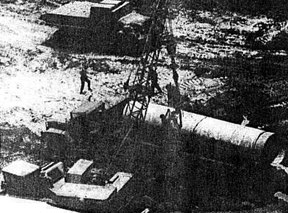 |
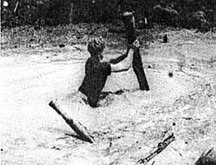 |
PUSH AND PULL - Even after demolition experts blew away most of the old bridge, a few parts of it remained. This soldier from A Company of the 65th Engineers had to go into the water to push and tug at this leftover log. | 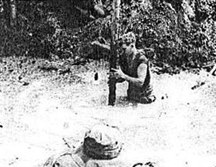 |
 |
UP AND OUT
- A rough terrain crane had to be called in to remove debris after the bridge was blown.
The wreckage had to be removed before the culvert could be installed and fill dumped in.
Use of the crane enabled the Tropic Lightning engineers to minimize the time it took them
to make the bridge available for traffic by local Vietnamese.
SETTING A CHARGE - Sergeant Leon E. Harris, Peoria, Ill., prepares an explosive charge and detonator cord to blow up the old bridge over the Soui Ben Rong River. Harris is a demolitions expert with A Company of the 65th Engineers. |
 |
 |
BRIDGE-WORK - After civilians and soldiers had been cleared from the bridge area, the charge was detonoted, sending most of what used to be a bridge sailing off into the hinterlands. After disposing of the old, the 25th Division troops attacked the problem of putting in the new. Installation of the culvert-based road that replaced the bridge completed an access artery between Highways 22 and 26. |
Page 6 TROPIC LIGHTNING NEWS May 12, 1969
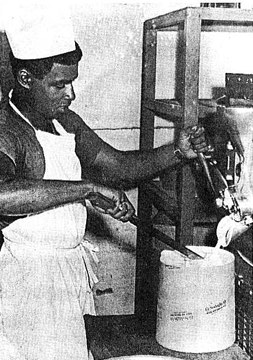 Dau Tieng’s Ice Cream
Men
Dau Tieng’s Ice Cream
Men
Keep 3d Bde in Good Humor
DAU TIENG - Nobody will see the Good Humor men of Dau Tieng wearing white
suits or playing tinny sounding music boxes.
Where they make and distribute ice cream, they don't need costumes and
musical sound effects to "sell" their product.
THE GOOD HUMOR men are Specialist 4
Billy Ware of Lake Charles, La.; Specialist 4 Bennington Hebron of Dorsey, Md., and
Private First Class Danny Robinson of Philadelphia. They operate the Dau Tieng ice cream
plant which manufactures 100 to 120 gallons of the taste treat daily.
"We have chocolate, vanilla, strawberry, lemon, peach maple, walnut and
blueberry." said Ware, adding "but we have no banana today."
THE PLANT features two ice cream
machines. "Not exactly the kind Grandma used," Ware said, "but the recipe
is just about the same."
The Good Humor men blend several cans of ice cream mix with cream shipped to
them from Long Binh. Almost-finished ice cream is poured into gallon containers and put
into freezers to harden. The Good Humor men not only supply the Dau Tieng base camp area,
but also Fire Support Bases Mahone II and Wood II.
COOL JOB - (Above) Specialist 4 Billy Ware, Lake
Chorles, La., draws off a fresh batch of homemade ice cream at Dau Tieng. After the ice
cream hardens in a freezer, it will be distributed to 3d Brigade soldiers. (PHOTO BY SP5
LARRY HAMILTON)
Dreadnaughts 'Audie II'
CU CHI - Vietnam has found its counterpart to Audie Murphy, the famous hero
of World War II. "Audie Junior," better known as Sergeant John Gentner,
Lexington, Mich., is a tank commander for Company A, 2nd Battalion, 34th Armor
Dreadnaughts.
During recent operations near the Ho Bo Woods, an element of the 238th NVA
Regiment decided to take on the Dreadnaught Armor. Gentner and his men immediately began
blasting the North Vietnamese with their machine guns and 90 mm cannons.
Early in the fight, Gentner moved to the .50 caliber machine gun mounted on
top of his tank and began firing on a sniper position. Suddenly the weld holding the
machine gun mount in place broke loose. As if this were not bad enough, the sudden
vibrations caused the pin holding the gun to the mount to fall out.
"It started beating on me and going all over the place," said
Gentner. One long burst found Gentner laying on his back with the machine gun on top of
him.
"I had to fire the .50 somehow, so I shoved it back on top of the
turret," he said. By grabbing the gun and placing his shoulder to the rear receiver,
he found he could get off five rounds bursts. Gentner, who weighs only 150 pounds, then
had to push the machine gun back into position so he could fire again.
For over four hours, "Audie Junior" alternated between firing the
main gun and rocking back and forth on top of the tank with his .50 caliber.
If you see a 5 foot, 6-inch tanker with a badly bruised right shoulder, say
"hello" to Audie Junior.
Shot Record - 1st
Brigade S-5 Gives
3,000 Inoculations in Three Hours
TAY NINH - Okay. So you can eat 100 eggs in an hour. Or stuff 50 men in a
foreign ear while holding your breath for 20 minutes. That’s great. But does it
really mean anything?
A truly meaningful record was set by the 1st Brigade’s S-5 (Civic
Action) section on a recent day when its medics inoculated 3,000 South Vietnamese
civilians against cholera in three hours.
The inoculations were part of a provincial campaign to obliterate serious
diseases.
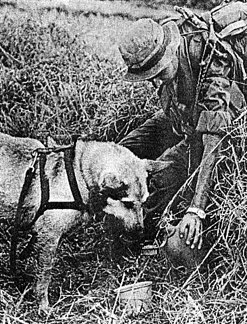 |
WETTING HIS WHISKERS - Shannon the scout dog needs at least as much water as his handler, Specialist 4 Peter Falcione, Nework, Conn. The 38th Scout Dog Platoon team was operating with the 2d Battalion, 27th Infantry, on an aerial assault near the Oriental River when they stopped for a drink. (PHOTO BY SP4 ROBERT B. WILIIAMS) |
Page 7 TROPIC LIGHTNING NEWS May 12, 1969
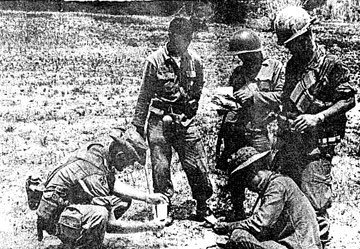 |
| INTERESTING READING - Men from a Vietnamese Regional Force Element and a Tropic Lightning patrol look over captured documents that led to the detention of more than 60 enemy suspects. Captoin Gerald Knapp of Oklahoma City (far left) studies one of the documents. He is a MACV advisor with the RF Company. Lieutenant Richard L. Nichols, Corvallis, Ore. stands at for right. |
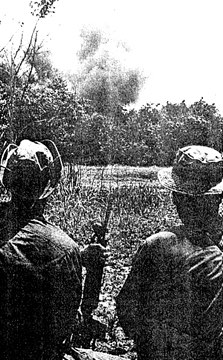 RFs, Tropic
Lightning Team to Play
RFs, Tropic
Lightning Team to Play
Homewrecker for NVA Battalion
TAY NINH - Soldiers from A Company, 65th Engineers, and C Company, 4th
Battalion, 9th Infantry, teamed with a Regional Force Company to play home-wrecker for the
enemy in an operation 14 miles south of Tay Ninh City.
The combined force destroyed most of a battalion-sized North Vietnamese Army
base camp that was well dug-in and heavily fortified. In searching the camp, they found a
number of documents.
The Tropic Lightning and the RF infantrymen secured the area while two
engineers flown in by helicopter from Tay Ninh base camp - Sergeant Victor P. Tarnasiewicz
of Gardner, Mass., and Specialist Four George A. Smalley of Mariana, Pa., made good use of
six cases of C-4 explosive but still couldn't destroy the whole camp. The base was dug
into a wooded area about 500 yards in diameter.
The battalion operations officer, Major Harry D. Ray, Jr., of Dillon, Mont.,
spotted the camp from his observation helicopter and ordered the two infantry companies in
on it.
The Tropic Lightning soldiers found two Chinese Communist 20-pound land
mines, 4000 yards of radio wire, and piles of freshly cut lumber gave strong indications
that the enemy may have been starting to rebuild the camp, Ray said.
FIRE IN THE HOLE - (Above) Two members of the 65th
Engineer Battalion watch from a safe distance as one of their charges destroys an NVA
bunker. The troopers are Specialist 4 George A. Smalley (left) of Mariana, Pa., and
Sergeant Victor P. Tarnasiewicz of Gardner, Mass.
 |
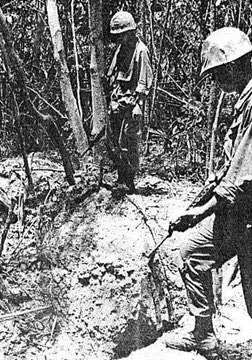 |
|
JUST MAKING SURE - (Above, left) Checking out part of a 700-yord long trench line that was part of the NVA camp, PFC Buford C. Spears of Nashville, Tenn. probes under overhead cover.
BYE BYE BUNKER - (Above, center) Specialists 4 Wayne A. Killian of Reading, Pa. (left) and Robert L. Nivens of Matthews, N.C. look at the remains of an NVA bunker.
SOWING DESTRUCTION - (Above, right) In top photo Specialist 4 George A. Smalley and Sergeant Victor P. Tarnasiewicz prepare a charge of C-4 explosive. On bottom, Tarnasiewicz places a charge inside an NVA bunker.
| PHOTO FEATURE BY SP4 RALPH NOVAK |
Page 8 TROPIC LIGHTNING NEWS May 12, 1969
Warriors Waste NVA, Slay 49
CU CHI - Second Brigade soldiers of the 2nd Battalion, 12th Infantry Warriors
climaxed a week-long series of contacts with the enemy in a fierce two-hour fight.
The infantrymen, supported by gunships, artillery and Air Force Tactical jet
fighters killed 49 enemy and took no
The Fire Brigade Warriors under the command of Lieutenant Colonel John C.
Manh, began a week of on-again, off-again contact with North Vietnamese Army and Viet Cong
forces on March 28; in joint operations with 1st Battalion (Mechanized), 5th Infantry, and
2d Battalion, 27th Infantry, soldiers.
THE WARRIORS’ Delta Company
killed six enemy during a sweep through heavy hedgerow complexes, in a pincer-like
movement which brought the Fire Brigade’s Alpha Company soldiers into close
co-ordination with the Delta Devils. As the Alpha Company men moved into the Delta Company
location they encountered and killed 16 NVA regulars in scattered actions.
The following day the Warriors killed two enemy soldiers and uncovered 6,000
pounds of polished rice.
The Delta Devils again scored, killing two VC during an enemy probe on their
night location. Simultaneously, Alpha Company soldiers killed another pair of insurgents
during an ambush patrol.
ON TUESDAY, Delta Company, while
manning a holding position, spotted an armed enemy soldier running from a treeline waving
a Chieu Hoi safe conduct pass. Company Commander Captain Paul F. Allen of Orlando, Fla.
advanced to meet the defecting Viet Cong.
As he and his interpreter began to talk to the former enemy, the woodline
erupted with small arms fire, killing the communist defector and wounding Allen.
Later the same day the Delta Company soldiers made their way into a night
location. Despite being mortared twice, they dug in for the long night of waiting.
AS THE TROPIC Lightning soldiers spent
the night in the small perimeter in bunkers dug along the rice paddies' dikes, movement
was spotted by a listening post. At first, 60 enemy soldiers were spotted moving toward
the company-sized location. As the company executive officer, First Lieutenant Toy M.
Smith of String, Tex. acting as company commander, received the reports, he called in
support firepower on the advancing enemy.
While artillery rounds exploded in the woodline, more enemy soldiers poured
out. Soon the insurgents were trapped between artillery to the rear and heavy Tropic
Lightning firepower to their front.
As the enemy assaulted the perimeter, "They hit us with
everything." Said Staff Sergeant Larry Pool of Norwalk, Ohio, acting second platoon
leader.
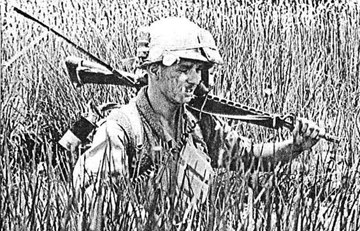 |
HELMET HANG-UP - The prime responsibility of a combat radio-telephone operator is to constantly keep his headset dry and monitored. Specialist 4 Thomus Roeske of Lansing, Mich., accomplishes this by fastening his headset along with other precious items high and dry with his elastic helmet band. (PHOTO BY SP4 R.B. WILLIAMS) |
No Hiding Place from
Hunter-Killer Teams
By Sgt Herb Bordett
TAY NINH - A most dangerous game of hide and seek for the highest possible
stakes goes on over the tree lines, hedgerows and jungles that are the area of operations
of the 1st Brigade.
Light Observation Helicopters (LolH’s) from C Troop, 3al Squadron, 17th
Cavalry, buzz the treetops; the downdraft from their rotors parts the thick overgrowth
revealing enemy base camps and the enemy himself.
WHILE THEIR LOH counter-parts hug the
ground, Cobra gunships fly overhead, watching, waiting for the enemy to be uncovered.
This is the Hunter-Killer team. Like the African warriors of old who flushed
the lion from his lair so the big game hunter could fire a killing shot, the LOHs continue
their search. Even though they are heavily armed, the crew flies knowing that a
well-aimed burst from an enemy ambush position could cripple and possibly down the craft.
They must be ready to dodge and dart, attack and evade until their teammate
can unleash his deadly barrage of rockets on the enemy.
The hunter-killers work hand in glove with the Air Force. Sometimes the LOHs
and Cobras spot the enemy and call for air strikes. On other occasions Air Force spotter
planes find traces of the enemy and call the hunters in for a closer look. In either case
the result is the same, another enemy position destroyed.
AN AIR FORCE OV10 spotter plane
piloted by Captain Harry Barr of Tuscaloosa Ala., circulated and directed artillery on a
known enemy base camp 12 miles north of Tay Ninh recently when he spotted what appeared to
be heavy trail activity a little further to the north. He called the Hunter-Killer team to
search the area.
 "I can smell food cooking and I see tables, chairs and
command bunkers and fighting positions still being camouflaged," radioed hunter pilot
Captain Ronald McDaniel of Columbus, Ga. The trail activity is immense. There are over 150
meters of trenchline," continued McDaniel .
"I can smell food cooking and I see tables, chairs and
command bunkers and fighting positions still being camouflaged," radioed hunter pilot
Captain Ronald McDaniel of Columbus, Ga. The trail activity is immense. There are over 150
meters of trenchline," continued McDaniel .
McDaniel’s observer on the LOH, Warrant Officer 1 Lance Bliss of
Seattle, Wash., saw truck tracks, a bridge, and signs of recent use.
It didn't take long for the Cobra overhead to go into action. Chief Warrant
Officer 2 Ward Harris of Muskogee, Okla., steered his gunship into position while ace
gunner Warrant Officer 1 Ray Knowles of Miami, Fla., strafed the enemy camp.
CAPTAIN MCDANIEL summoned the Air
Force forward air controller back on station and jet bombers were soon dropping their
payloads on the Viet Cong hideaway. For three days the strikes continued, destroying huge
chunks of the triple-canopied jungle below.
As the smoke from the last strike began to clear, Captain McDaniel went in to
assess the damage. Under the watchful eye of big brother Cobra he searched every foot of
the camp, darting and weaving, brushing the treetops. He confirmed the destruction of 36
bunkers, 15 fighting positions, and 400 meters of trench line.
This is but one example of how the hunter-killer team and their Air Force
cousins serve the 1st Brigade.
They continue their daily search missions, discovering camps and caches, rocket and mortar
positions and groups of Viet Cong. Helicopter support often provides the margin of victory
for U. S. forces in Vietnam.
The hunter-killer concept is the ultimate in helicopter support and the C
Troop, 3d Squadron, 17th Cavalry, works it to perfection .
AN AIR FORCE JET (Above, right) called in by
Captain Harry Barr of Tuscaloosa, Ala., helps destroy over 400 meters of trench line near
the Cambodian border west of Tay Ninh. (PHOTO BY SP4 DAVE DE MAURO)
Charlie Moves Out As
Regulars Move In
TAY NINH - For two days running, infantrymen from the 3d Battalion, 22d
Infantry Regulars met the enemy head-on in fierce fighting near a VC base camp six and
one-half miles north of Tay Ninh City.
Forced to hastily abandon the hidden camp within the jungle near War Zone C,
the enemy left behind a 120mm mortar tube and other supplies.
The large complex, strung out over several miles, contained a number of
bunkers. Just a day before, the Lancer Brigade troops had tangled with an NVA force
guarding the outpost. Nineteen enemy were killed in that battle.
First Lieutenant William Ervin of Brunswick, Ga., led his unit into the area
while pinch-hitting for his commander, who was wounded the day before. First Lieutenant
James Trebilcock led the other regular company in the action. Both units assaulted into
the area the next day expecting to meet heavy resistance, but the NVA had fled.
A sweep of the area turned up an 82mm mortar tube, ten 107mm rockets, a
Chinese communist radio, small arms ammo, narcotics, propaganda leaflets, and a 102mm
mortar base plate. A mine detector revealed the rest of the mortar.
"We would never have found the 120mm mortar tube if we hadn't had that
minesweeper,'' said Trebilcock. "It wasn't buried very deep, but it was well
camouflaged."
Both the 82mm and 120mm mortars were complete with baseplates, bipods and
aiming quadrants.
Bobcats...
(Continued From Page 1)
Captain Randall Yeargen, San Antonio, Tex., coordinated air attacks with probing actions
by his own infantrymen. Sergeant Raymond Kenny of New York, N.Y., summed up the day:
"When contact broke near dark, we still had a considerable distance to
travel before reaching our laager site. We didn't get there until midnight. It was a long
day."
While it was a long day for the Bobcat company, it was the last day for 17
NVA.
ON THE SECOND day, the Bobcats' C
Company entered the enemy held area along with a company from 2d Battalion, 12th Infantry
to support A Company in eliminating determined elements of the NVA unit.
Beginning on a sweep of the area, each company formed a leg of an L-shaped
formation. With the thought of the previous day’s contact in mind, everyone was
exceptionally alert.
Sergeant James MacFarlane of Philadelphia, explained it this way:
"Usually Charlie waits until we are 25 feet from him. But this time he waited until
we were ten feet away before he opened up."
Cache 'n Carry
TAY NINH - The 4th Battalion, 9th Infantry Manchus located a weapons cache
containing more than 200 rounds of enemy ordnance, including 72 75mm recoilless rifle
rounds and 100 mortar rounds recently.
The Manchus of Bravo Company, patrolling nine miles southeast of Tay Ninh,
gathered up 25 rocket-propelled grenades and five AK-47 rifles in addition to the other
ammunition.
'Hounds Seek, Discover
NVA
DAU TIENG - "Wolfhounds" of Bravo Company, 1st Battalion 27th
Infantry recently spotted a group of North Vietnamese Army Regulars playing a go-for-broke
game of hide-and-seek near their position.
The infantrymen responded with a "ready-or-not-here-we-come" that
resulted in five enemy dead near Fire Support Base Mahone II.
A sweep force in the area discovered four of the bodies clad in black
pajamas. The other dead enemy soldier was wearing a green uniform and bush hat. No weapons
or documents were found.
The Bravo company "Wolfhounds" were assisted by cannoneers from 2nd
Battalion, 77th Artillery.
Thanks to
Ron Leonard, 25th Aviation Bn. for locating and mailing this issue,
Kirk Ramsey, 2nd Bn., 14th Inf. for creating this page.
This page last modified 8-12-2004
©2004 25th Infantry Division Association. All rights reserved.